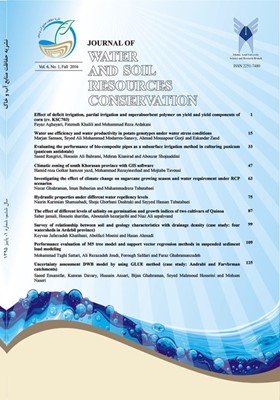Evaluating the Performance of Biocomposite Pipes as a Subsurface Irrigation Method in Culturing Panicum (Panicum antidotale)
Subject Areas : Farm water management with the aim of improving irrigation management indicatorssaeed rangrizi 1 , hosseinali bahrami 2 , mehran kianirad 3 , aboozar shojaaddini 4
1 - دانشآموخته کارشناسی ارشد علوم خاک؛ دانشگاه تربیت مدرس؛ تهران؛ ایران
2 - دانشیار؛ گروه علوم خاک؛ دانشگاه تربیت مدرس؛ تهران؛ ایران
3 - استادیار پژوهشی؛ پژوهشکده زیستفناوری سازمان پژوهشهای علمی و صنعتی ایران؛ تهران؛ ایران
4 - دانشآموخته کارشناسی ارشد علوم خاک؛ دانشگاه تربیت مدرس؛ تهران؛ ایران
Keywords: panicum, porous clay capsules, subsurface irrigation, bio-composite water pipes,
Abstract :
Considering the limited access to fresh water resources and intense plant respiration and high evapotranspiration in deserts and arid regions, subsurface irrigation seems to be the most appropriate method for cultivation. The aim of this study was finding a proper subsurface irrigation to supply moisture for plant roots using bio-composite water pipes to supply water for panicum. Experimental design was factorial experiment conducted based on completely randomized block design with three replications in the Faculty of Agriculture in Tarbiat Modarres University in 2015. Main factors included subsurface irrigation using three types of bio-composite water pipes manufactured P3, P8, P9, subsurface irrigation using subsurface porous clay capsules and flood irrigation (control treatment). Secondary factors included three drought stress levels of 25, 50, and 100% of soil field capacity (FC). Results showed that, subsurface irrigation treatment using water pipe P8 and drought stress level of 25%, and FC decrease for 12.68%, was the lowest water consumption in irrigation. In addition, in subsurface irrigation, height, wet and dry weights were significantly different at %1 level compared to flood irrigation. Therefore, with regard to responsiveness of panicum water demand to subsurface irrigation using bio-composite water pipes, and considering the results of this research using subsurface irrigation by bio-composite water pipes, it is recommended to optimize water consumption for urban areas located in arid and semi-arid regions.
انصاری، ح.، نادریانفر، م.، رمضانی، ح. و جلینی، م. 1393. مقایسه و ارزیابی برخی شاخصهای رشد گونههای غالب فضای سبز شهری در سیستمهای آبیاری زیرسطحی سفالی، قطرهای و سطحی. نشریه آبیاری و زهکشی ایران، 8 (2): 402- 412.
ایرانمنش، ف.، عرب خدری، م. و اکرم، م. 1384. بررسی مناطق برداشت ذرات گرد و غبار و ویژگی های انتشار آنها در طوفان های منطقه سیستان با استفاده از پردازش تصاویر ماهواره ای. پژوهش و سازندگی در منابع طبیعی، 67: صفحات 25-33.
آذرنیوند، ح. 1382. بررسی ویژگیهای گیاهشناسی و اکولوژیک دو گونه Artemisia sieberi و Aaucheri در دامنه جنوبی البرز. پایاننامه دکتری مرتعداری. دانشکده منابع طبیعی. دانشگاه تهران.
بابایی، ک.، امینی دهقی، م.، مدرس ثانوی، ع م. و جباری، ر. 1389. اثر تنش خشکی بر صفات مورفولوژیک، میزان پرولین و درصد تیمول در آویشن. فصلنامة علمی-پژوهشی تحقیقات گیاهان دارویی و معطر ایران، 26 (2): 251-239.
دستورانی، م. ت.، صادقزاده، م. ع. و حشمتی، م. 1387. بررسی کارآیی آبیاری زیرسطحی در میزان رشد و تولید درختان پسته. مجله علوم و صنایع کشاورزی. ویژه آب و خاک، جلد 22 (1): 35-47.
رنگریزی، س.، بهرامی، ح ع. کیانیراد، م و شجاعالدینی، ا. (1394). ساخت تنبوشههای بیوکامپوزیتی بر پایه استفاده از الیاف خرما جهت آبیاری زیرسطحی گیاهان در مناطق خشک و نیمهخشک. دومین کنفرانس ملی کشاورزی و توسعه
قربانی واقعی، ح.، بهرامی، ح ع، علیزاده، پ و نصیری صالح، ف. (1390). ویژگیهای هیدرولیکی کپسولهای رسی متخلخل و تاثیر آن بر توزیع رطوبت خاک. مجله پژوهش آب ایران، 9: 131-141.
قربانی واقعی، ح.، بهرامی، ح ع. و رشیدی جوشقان، م. (1393) کپسولهای رسی متخلخل و کاربرد آنها در تامین نیاز آبی گیاهان مناطق خشک و نیمه خشک. فصلنامه بین المللی و پژوهشی منابع آب و توسعه، 2: 26-20.
کاظمینژاد، ا ع.، باغستانی میبدی، ن. و کریمی، ا. ع. 1385. بررسی تاثیر روشهای مختلف آبیاری براستقرار گونههای درختی مثمر و غیرمثمر در مناطق بیابانی. فصلنامه پژوهش و سازندگی، 71: 89-94.
کاظمینژاد، ا ع.، کارگر، ع.، کارگر، ح.، صدری، ص.، دهقان، ع.، غضنفریان. و ا و کبریایی، ح. 1386. بررسی اثر آبیاری زیرسطحی در رشد و نمو درخت تاغ در مناطق بیابانی با استفاده از لولههای سفالی. فصلنامه جنگل و مرتع، جلد74: 88-93.
ناصری، ا.، بابازاده، ح و نخجوانی، س. 1390. انتخاب مناسبترین دبی گسیلنده با تحلیل توزیع رطوبت از یک گسیلنده نقطهای. حفاظت منابع آب و خاک، 1 (1): 29-42.
هادیراد، م.، میرحسینی، ر.، مشکوه، م ع. و سلطانی، م. 1387. بررسی تاثیر مقادیر مختلف رطوبت خاک بر کارآیی مصرف آب (WUE) در گیاه تاغ. پژوهش و سازندگی در منابع طبیعی، جلد 80: 75- 82.
Bainbridge, D. 2001. Buried clay pot irrigation a little known but a very efficient traditional method of irrigation. Agriculture Water Management, 48: 79-88.
Chiatante, D., Di-Iorio, A., Sciandra, S., Stefania, G. and S. Mazzoleni. 2006. Effect of drought and fire on root development in Quercus pubescens wild and Fraxinus ornal seedlings. Environmental and Experimental Botany, 56: 190-197.
Hoekstra, F., A. Golovia. and J. Buitink. 2001. Mechanisms of plant desiccation tolerance. Trends plant Sci, 6: 431-438.
Jiusheng, Li., Zhang, J. and M. Rao, 2004. Wetting patterns and nitrogen distributions as affected by fertigation strategies from a surface point source. Agricultural Water Management, 67: 89-104.
Masinde, P.W., Stutzel, H., Agong, S. and A. Goand- Fricke. 2006. Plant growth, water relations and transpiration of two species of African nightshade (Solanum villosum Mill. ssp. Miniatum (Bernh. Ex Willd.) Edmonds and S. sarrachoides Sendtn.) Under water-limited conditions. Scientia Horticulturae, 110: 7-15.
Sathiyamoorty, P. and S. Nukamura. 1995. Effect of gibberalic acid and inorganic salts on breaking dormancy and enhancing germination of true potato seed. Seed Res, 23: 5-7
Siyal, A.A. and T.H. Skaggs. 2009. Measured and simulated soil wetting patterns under porous clay pipe sub-surface irrigation. Agricultural Water Management, doi:10.1016/j.agwat.2008. 11.013.
Siyal, A.A., Siyal, A.G. and M.Y. Hasini. 2011. Crop production and water use efficiency under subsurface porous clay pipe irrigation. Vet. Sci, 27: 39-50.


